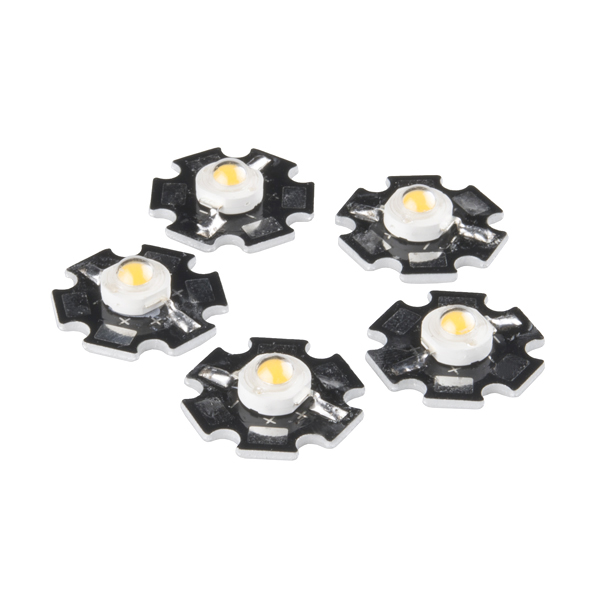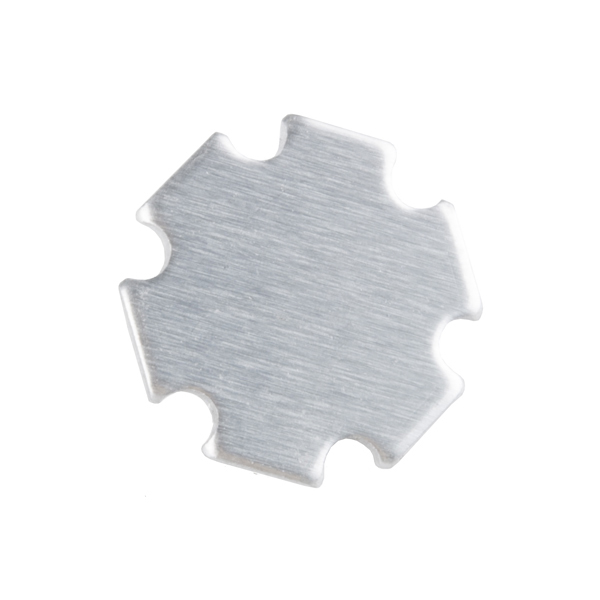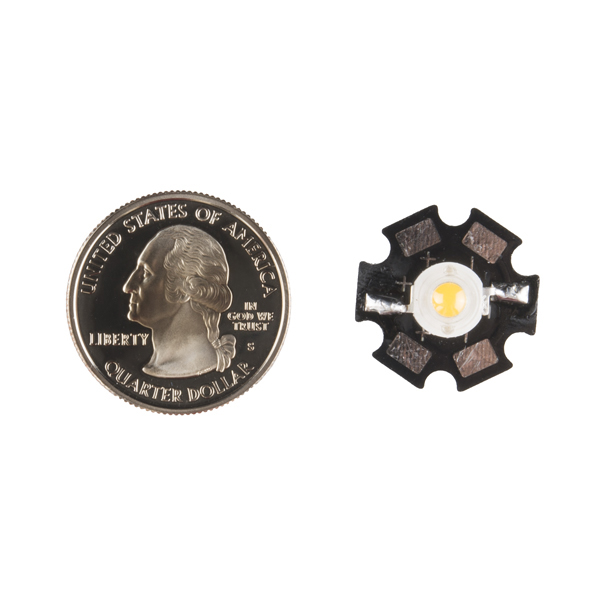LED - 3W Aluminum PCB (5 Pack, Warm White)
So much power and light from such a small package. This 5 pack of "Warm" white 3 Watt aluminum backed PCBs is sure to shed a lot of light on any project you add it to. These LEDs act as any other LED except these little guys require much more power while delivering a light as intense of a thousand suns going super nova (this is an exaggeration but you know what we mean)!
Each LED in the pack sits upon an aluminum backed PCB to help with heat dissipation and emits a warm white light. Additionally, each LED requires a forward voltage of 3.2-3.8V at 750mA.
Note: We like to joke around about super novas and all, but seriously, don't look directly into the LED.
- Forward Voltage: 3.2-3.8V
- Forward Current: 750mA
- Viewing angle: 125±5 Degrees
- Luminous Intensity: 160-200LM
- Temperature Color: 3000-3300K
- Datasheet
- Product Video
- Related Hookup Guides:
LED - 3W Aluminum PCB (5 Pack, Warm White) Product Help and Resources
Touch Potentiometer Hookup Guide
October 22, 2015
Learn how to use the SparkFun Touch Potentiometer to control lighting, volume or other inputs in your daily life.
FemtoBuck Constant Current LED Driver Hookup Guide v13
December 10, 2015
The FemtoBuck board is a high-efficiency, single-channel constant-current LED driver.
PicoBuck Hookup Guide v12
February 18, 2016
The PicoBuck board is a high-efficiency three-channel constant-current LED driver.
Magnetic Levitation
November 20, 2019
This tutorial will show you how to build a magnetic levitation circuit using common parts.
Core Skill: Soldering
This skill defines how difficult the soldering is on a particular product. It might be a couple simple solder joints, or require special reflow tools.
Skill Level: Competent - You will encounter surface mount components and basic SMD soldering techniques are required.
See all skill levels
Core Skill: Electrical Prototyping
If it requires power, you need to know how much, what all the pins do, and how to hook it up. You may need to reference datasheets, schematics, and know the ins and outs of electronics.
Skill Level: Rookie - You may be required to know a bit more about the component, such as orientation, or how to hook it up, in addition to power requirements. You will need to understand polarized components.
See all skill levels
Comments
Looking for answers to technical questions?
We welcome your comments and suggestions below. However, if you are looking for solutions to technical questions please see our Technical Assistance page.
Customer Reviews
4.6 out of 5
Based on 8 ratings:
1 of 1 found this helpful:
Great, and bright, lights
These are very bright. I used one set of 5 to light up my workbench. They are a little difficult to solder. I had to use flux and my iron at a high temp. Once I used the flux, they soldered well. I would appreciate a soldering tutorial if Sparkfun wanted to offer one.
LED lights with femto buck
These things work great.
Replaced under counter lights.
Biased these at 375 mA. Working out great. These are on probably about 10 hours per day, a little over 1 year. No failures so far.
Great for repair of outdoor lanterns
Exactly fits the LEDs used in outdoor LED lanterns from Altair that were on sale at Costco's a few years back. Half of them broke after 3 years, replacing the LEDs will hopefully give them another 3 years. They are working alright for now, cannot say anything about actual product life yet.
Works well.
I bought these to replace a blown LED module in a cheap desk light. Working well so far and an improvement on the one it replaced.
Not as warm a white as I had expected though.
Great LED's
They were easy to set up and produce lots of light. I will be buying more of these
These worked spectacularly!
I made a "magic wand" with a crystal that lights up very bright when I press a button. One of these LEDs did the trick. VERY bright!
Now I have to just come up with something to use the other 4 on :-)







What type of heatsink is suggested for these LEDs. I can't seem to find any sort of information on the datasheet to help me with this info?
Work great with the new picobuck.
Does anyone have a source for reflectors to mount these in?
I found Red, White and Blue. I am the only one missing Green? My plans involve RGB.
Who needs green light? ;) Plants reflect most of the green light. They utilise mostly red and blue..
Here's a little image showing what wavelengths photosynthesis occurs on http://www.sd84.k12.id.us/shs/departments/science/yost/Biology/5%20-%20Energy%20&%20Metabolism/chlorophyll_absorption_graph.jpg
P.S I like the direction SF is going, starting to sell peristaltic pumps, R/B LED's, Constant current supplies, Atlas Scientific probes (K0.1 plz), etc.
Also, your plants aren't using the white LEDs, nor are they using the red LEDs sold in this form factor, 620 nm isn't really used much by chlorophyll. Are there datasheets for these LEDs? I'm having a hard time finding good details outside of the product description, I'm looking for the output curves, and watts/lumens ratios.
Red, Green and Blue are primary colors, which means you can create any color by blending different amounts of these three.
So, in answer to your question, your plants may not need the green light, but anyone (like me) wanting to create a light with any color needs green along with red and blue.
Sorry, no green :-(
Thank you for your answer! Are they not manufactured in green, or did you just decide not to stock them? The number of possible applications of these leds increases significantly if there were three primary colors. So you would probably sell more of red and blue if you had green as well.
Looks like they do have green after all! Green are coming. Thanks for the suggestion.
You just made my day. And more importantly, by reading and taking action so quickly based on my comment, you just made me a lifelong SparkFun-loyal customer. Thank you!
I don't think the manufacturer had green. I'll double check.
The FemtoBuck can only drive 350mA, these seems to be rated to 750mA.
Will they not be glowing with 100% capacity using the Femtobuck?
I am having trouble soldering to the flat pads. Does anyone have any advice for soldering to them? I held my iron to the pad, placed the wire adjacent, and then added the solder. I could not get the pad to heat up enough for the solder to flow, it just flowed onto the wire.
Only two bits of advice: 1. Add some flux, and 2. Make sure you use a good high-powered soldering iron. A small pen iron is probably just not going to cut it as the heat gets whisked away through the board. You basically want to heat it up very quickly just on the tabs without the entire board heating up, and for that you need power. Lastly, if it's just not working out, you could try soldering to the legs of the LED component itself, just between their housing and where they're soldered to the board. I'd consider that almost as a last option, but as long as you get a solid solder joint in there (hook the wire around) and consider strain reliefs on the wires, it shouldn't pose a problem in typical use.
I am having trouble soldering to the flat pads. Does anyone have any advice for soldering to them? I held my iron to the pad, placed the wire adjacent, and then added the solder. I could not get the pad to heat up enough for the solder to flow, it just flowed onto the wire.
Could these work as bicycle headlights? All 5 at once in a little aluminum housing?
I've got a bike light that's got a single LED (but with a parabolic reflector). The LED is about the same specs as one of these, and it's blinding.
So if you were to build one with all five, it would certainly be bright. You might need something a bit larger than "a little aluminum housing" though.
Thanks I'm in ! I can make an aluminum housing
Can you run a 12V power supply with these?
If the forward voltage must be between 3.4-3.6V you can put them safely 4 of them on series, they are going to glow a little bit less but them are not going to require additional wiring. Just be sure that the 12V voltage source can provide at least 2.8A.
The power supply does not need to provide 2.8A. It only needs to provide at most 700mA, actually a lot less since you won't be running them at the full current.
You are right, my wrong. In you put 4 them in parallel you are going to need at least 3.5v@2.8A, in series 12V@700mA would be enough as you said. Sadly I don't see a datasheet, may be he can put 3 of them in series and over-drive them a little bit (even reducing their lifetime if the he doesn't care).
This looks like a great product. What is the rated CRI, color temperature, lumen maintenance vs. time, recommended thermal resistance of the heatsink, and maximum junction temperature for this LED. Can you provide the datasheet for these?
I think this might be it: http://www.vollong.com/UploadFiles/2011/13/2011131951237252.pdf At least the picture matches and the specs can be found in the mddle of the page. A CRI of 60 (for WW) doesn't seem too spectacular these days.
I used to buy 1 watt LEDs in this form with a built in driver from another source. It was a simple and cheap way to create LED lights. I would like to suggest stocking something like the LED strips that another vendor carries http://www.goldmine-elec-products.com/prodinfo.asp?number=G20003 These are available in a variety of voltages. The driver is built in. You just add the correct DC voltage and you are good to go. I wish these things had proper holes for mounting to projects however.
Supernova? I think not :-) : https://what-if.xkcd.com/73/
Which of the following would be brighter, in terms of the amount of energy delivered to your retina:
* A supernova, seen from as far away as the Sun is from the Earth, or
* The detonation of a hydrogen bomb pressed against your eyeball?
Applying the physicist rule of thumb suggests that the supernova is brighter. And indeed, it is ... by nine orders of magnitude.
Need I say more?
Oh, and thanks for the shiny quarter.